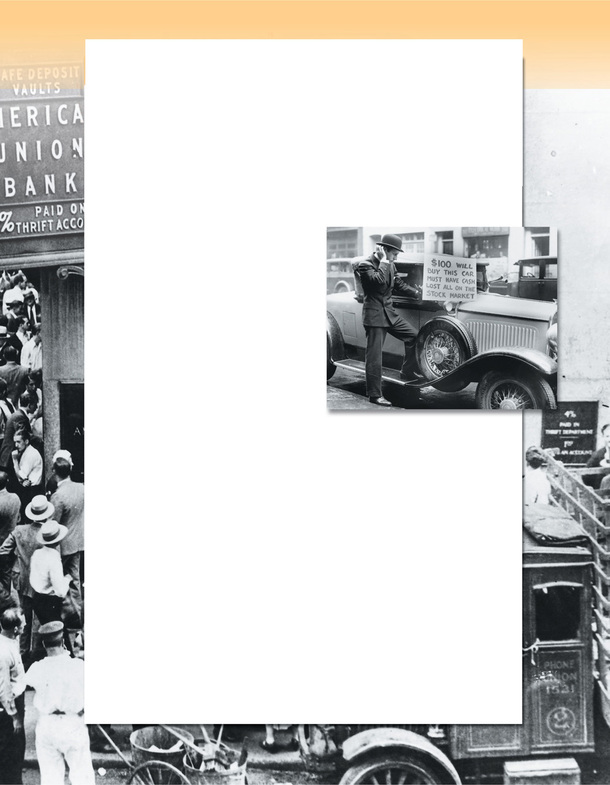Real-life Case Study: Banking, Monetary Policy, and the Great Depression
Monetary and Fiscal Policy
In 1929, the collapse of the stock market touched off a period of economic devastation known as the Great Depression. Millions of Americans found themselves unemployed and lost their homes, farms, and life savings.
Bank Failures In late October 1929, dropping stock prices caused many panicked investors to sell their stocks, which resulted in the collapse of the stock market on October 29, 1929. Banks had invested heavily in the stock market and lost huge sums. Fearful that banks would run out of money, people rushed to their banks demanding their money. To pay back these deposits, banks had to recall loans from borrowers, but they could not do so fast enough to pay all the depositors demanding their money. Thousands of banks failed.

Countless investors lost everything in the Crash of 1929.
Emergency Action In 1933, President Franklin D. Roosevelt took emergency action and declared a bank “holiday.” All banks closed temporarily to stop the banking panic. Congress then passed the Banking Act of 1933, which created the Federal Deposit Insurance Corporation (FDIC) to insure deposits. This meant that even if a bank failed, deposits would be guaranteed by the federal government.
Meanwhile, banks became extremely cautious. They made fewer loans and kept enough cash on hand in case depositors all came at once to withdraw their funds. Banks began to hold substantial reserves, far in excess of those required by the Federal Reserve.
Federal Reserve Response These excess reserves concerned the Federal Reserve, which feared that banks might distribute that money, possibly causing inflation. In 1937, the Fed raised reserve requirements for the banks, thus lowering the money supply to prevent inflation. Banks responded by cutting back their loans even further to have enough cash for depositors.
This Federal Reserve policy had an unintended negative result. Banks reduced lending, which led to a recession. Since that time the Fed has learned not to make sharp increases in reserve requirements.
Applying Economic Ideas
- Why did the Federal Reserve raise reserve requirements in 1937?
- Were banks justified in holding excess reserves in the 1930s? Why or why not?
Table of Contents
- Section 1 Benefits of Free Enterprise
- Section 2 Promoting Growth and Stability
- Section 3 Providing Public Goods
- Section 4 Providing a Safety Net
- Real-life Case Study: Government and the Interstate Highway System
- Chapter 3 Assessment
- The Wall Street Journal. Classroom Edition Debating Current Issues: Health-Care Costs
- Section 1 Perfect Competition
- Section 2 Monopoly
- Section 3 Monopolistic Competition and Oligopoly
- Section 4 Regulation and Deregulation
- Real-life Case Study: Regulating Cable Television
- Chapter 7 Assessment
- The Wall Street Journal. Classroom Edition Debating Current Issues: Oil and Energy Dependence
- Section 1 Levels of Development
- Section 2 Issues in Development
- Section 3 Financing Development
- Section 4 Transitions to Free Enterprise
- Real-life Case Study: The World Bank and Economic Assistance
- Chapter 18 Assessment
- The Wall Street Journal. Classroom Edition Debating Current Issues: Tariffs and Trade




